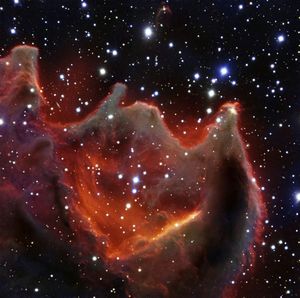CG 4
| سحابة جزيئية | |
|---|---|
| Bok globule | |
 | |
| بيانات الرصد: حقبة J2000 | |
| الصعود المستقيم | 07س 34د 09.0ث[2] |
| الميل | −46° 54′ 18″[2] |
| المسافة | 1,300 س.ض. (400 pc) |
| الكوكبة | Puppis |
| السمات الطبيعية | |
| الأبعاد | 1.5 × 8 ly (0.46 × 2.45 pc) |
| تسميات | BHR 21, DCld 259.4-12.7, FEST 2-30, Sandqvist 103 |
CG 4، يشيع الإشارة إليها بإسم يد الرب God's Hand،[3] is a star-forming region located in the Puppis constellation, about 1،300 سنة ضوئية (400 pc) from Earth.[4] It is one of several objects referred to as "cometary globules", because its shape is similar to that of a comet.[1] It has a dense head formed of gas and dust,[1] which is around 1.5 ly (0.46 pc) in diameter,[3] and an elongated faint tail[1] around 8 ly (2.5 pc) in length.[3]
CG 4, and the nearby cometary globules, generally point away from the Vela Supernova Remnant, located at the center of the Gum Nebula.[5]
الاكتشاف
In 1976, photographs from the UK Schmidt Telescope—operated by the Australian Astronomical Observatory—showed several objects resembling comets, located in the Gum Nebula,[1] an emission nebula of the constellation. Due to their particular shape, these objects came to be known as cometary globules.[1] Each globule has a dense, dark, ruptured head and a very long tail, with the latter pointing away from the Vela Supernova Remnant. As a part of the ESO Cosmic Gems program, the European Southern Observatory released an image of CG 4 in January 2015 showing the head of the nebula.[1]
البنية
The head of cometary globule CG 4 resembles a comet with a dusty cavernous mouth, as photographed by the European Southern Observatory's Very Large Telescope in 2015.[6] Composed of relatively dense, dark matter, it is an opaque structure that is being illuminated by the glow of a nearby star.[7] An obscure red glow limbing the globule is possibly caused by emission from ionized hydrogen. The mouth of the globule appears to be ready to consume the edge-on spiral galaxy ESO 257-19, located in the upper left corner of the image. In reality, the galaxy is over a hundred million light-years further away from the globule.[8]
الهامش
- ^ أ ب ت ث ج ح خ "The Mouth of the Beast: VLT images cometary globule CG4". European Southern Observatory. January 28, 2015. Retrieved January 31, 2015.
- ^ أ ب "[DB2002b] G259.43-12.72". SIMBAD. Centre de données astronomiques de Strasbourg. Retrieved November 14, 2016.
- ^ أ ب ت "God's Hand: Astronomers Capture Cometary Globule CG4". Sci-News. January 28, 2015. Retrieved January 31, 2015.
- ^ "Cometary Globule CG4". National Optical Astronomy Observatory. Retrieved January 31, 2015.
- ^ "Staring into the Maw of a Mysterious Cosmic Globule". Seeker. January 28, 2015. Retrieved January 31, 2015.
- ^ "Image of Cometary Globule Marks 1,000 Online at NOAO". National Optical Astronomy Observatory. March 8, 2006. Retrieved January 31, 2015.
- ^ Starr, Michelle (January 28, 2015). "Mysterious nebula revealed in new image: 'Mouth of the Beast'". CNET. Retrieved January 31, 2015.
- ^ Charlton, Seth (January 29, 2015). "ESO's Very Large Telescope Captures Cometery Globule CG4". Voice Chronicle. Archived from the original on February 1, 2015.
{{cite web}}: Unknown parameter|deadurl=ignored (|url-status=suggested) (help)